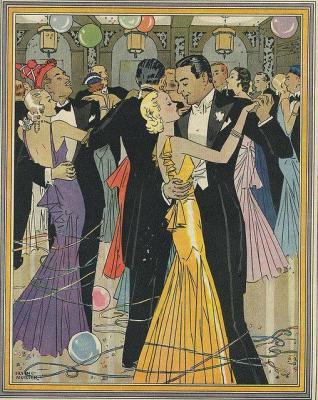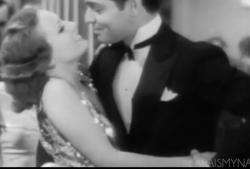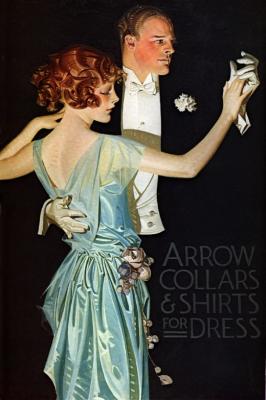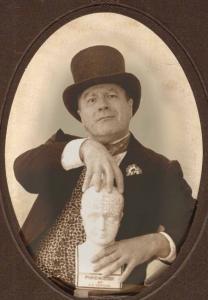Walter's Random Musings
"Cocktail Dancing": What's in a Name?
 As anyone who has seen my social media posts for the last couple of years will know, I have been focused on recreating the social dances of the 1920s, 30s and ā40s ā not the youth dances like Charleston and Swing (they donāt need my help) but the, at the time, far more widely danced Foxtrots, Waltzes and Tangos.
As anyone who has seen my social media posts for the last couple of years will know, I have been focused on recreating the social dances of the 1920s, 30s and ā40s ā not the youth dances like Charleston and Swing (they donāt need my help) but the, at the time, far more widely danced Foxtrots, Waltzes and Tangos.
I have come to the conclusion that this style of dance I have been advocating is really its own style, distinct from modern ballroom, swing dance etc. It really needs its own name.
These dances, in their original forms, were far less structured, far less strictly defined, far more intimate and far easier than their current āDancing With the Starsā or "International Ballroom" forms. It is a style of dance that I think has a lot to offer our modern world, and I would love to see it revived and spread beyond a narrow, historical dress-up sort of audience.
At the time, these dances were called āThe Modern Dancesā, but āModern Danceā is a term that has become inextricably associated in our own time with styles of artistic performance dance ā successors to ballet, so āModern Danceā is pretty much taken, and another name is required to describe this unique style. Besides, āmodernā is an adjective that has something of a set āsell byā date, and becomes just a bit ironic when applied to a dance style thatās about a century old.
I have been referring to them as āJazz Age Social Dancesā, which sets them in their proper historical context, but also locks them into the past. It defines them as a museum artifact. Itās as if you called Swing Dancing āGreat Depression Dancingā or āWorld War Two Dancingā.
I suspect a hard-wired link to the past could be impediment to a broader acceptance of this sort of dancing.
So, what can we call this style, with its focus on social connection, simple enjoyment and sophistication, that conveys its unique spirit and essence?
Dancing in A Dockside Dive in 1928
This scene, in which dancing figures prominently in the background, gives a sense of the sorts of dancing a movie audience would expect to see in a sleazy dive in New York in 1928. It's from "The Docks of New York"
Dancing in a Parisian Dive in 1921
The dance scenes from the 1921 French film Fievre, showing low-down Jazz Age dancing in a low down venue full of drunk, unhappy people. I pasted "The Montmartre Rag" and "Around the Bois de Boulogne" onto the silent footage.
1920s Fox Trot and Waltz - Dance Scenes from "Regent Hall".
I happened on this fragment of an obscure British film set in a dance hall that contains a lot of nice detail. I also love it when they put up a sign saying "Fox Trot" or "Waltz" to remove any doubt. I am a bit disappointed they flashed a One Step sign, but didn't show it. I am curious what a British One Step would look like given how One-Steppy their Fox Trots are. You would seldom see a dance called a One Step in the States by this time.
Video - Dancing the Fox Trot to Happy Days Are Here Again in 1930
This video, made up of Fox Movietone News rough footage from 1930, shows in great detail, ordinary folks dancing the Fox Trot in 1930.
The Baltimore Fox-Trot Variation
Various British dance champions demonstrate the Baltimore.
0. The Essentials of Jazz Age Ballroom Dancing

In the Jazz Age, almost everyone danced so they did a dance almost anyone could do.
In my zeal to document the social dances of the Jazz Age, I have built a rather large and intimidating collection of web pages and videos (the menus on the left and right of this page attest to that), which while they may be of interest to the aficionado, might be a bit much for a busy person in a hurry. So, I have briefly summarized my key points.
These observations relate primarily to Fox Trot, which was the fundamental foundation of almost all the dancing of the time and a promiscuously applied catch-all name for any dance in 4-4 time. Most of this also applies to the two other common Ballroom dances of the time: the Waltz and the Tango. For discussion of how the youth dances (Charleston, Swing etc.) Latin dances and the like fit into all of this, click on the links on both sides of this page.
To begin:
It's Different: The Foxtrot of today IS NOT the Fox Trot of the Jazz Age. Dances evolve over time, and what you see today called the Foxtrot is not what you see in the old movies.
Why Men Don't Dance Anymore and a Few Thoughts on Fixing That
In this brief posting, I will muse on what went wrong with dancing that made men desert the dance floor, and end with a few ideas I try to put into practice to make them a little more willing to get out of their chairs and dance. Much of what I say applies equally to women, but for this particular post, I'm singling out the guys.
 There was once a time, not so long ago, when everyone, men and women, danced. Every public space had a dance floor and regular live music, most restaurants had dancing, every hotel hosted regular dances, and you couldnāt have a celebration or large social gathering without dancing. When men felt lonely and isolated, they would go to a taxi dance hall and pay women to dance with them. Dancing was central and essential to society and to the way men and women interacted.
There was once a time, not so long ago, when everyone, men and women, danced. Every public space had a dance floor and regular live music, most restaurants had dancing, every hotel hosted regular dances, and you couldnāt have a celebration or large social gathering without dancing. When men felt lonely and isolated, they would go to a taxi dance hall and pay women to dance with them. Dancing was central and essential to society and to the way men and women interacted.
Through the '40s and '50s, general public dancing was in a slow decline, but was still pretty widespread. Then, around the 1960s, something fundamentally changed and men, who had always had a tendency to be less enthusiastic about dancing than women, started to withdraw from the dance floor. When they were kids, they would reluctantly join the girls for some freestyle gyration, but as soon as possible, most of them found an excuse to sit down.
Today, social dancing is almost dead. Outside of certain very specific contexts like āthe club sceneā, formal ballroom dancing, swing dancers, weddings etc., most social occasions, even when they include music (often REALLY loud music), do not include any sort of dancing and when they do, itās almost exclusively the women who dance. (an aside: I think that the deafening volume of most public music today is an attempt to try to fill the void left by dancing. I have no evidence to support this, I simply think it so)
So, what happened? Why are men so reluctant to dance anymore?
1930s Foxtrot - A Public Dance at a Resort
This video is from a collection of raw footage and out takes from Fox Movietone News. I cut it down to the dance related bits from the footage I found on the University of South Carolina website.
From 1930, at the Poinciana Breakers Casino in Palm Beach Florida, ordinary folks dancing the Fox Trot in the sort of general public dancing that used to be found everywhere.![]()
The Wearing (or not Wearing) of Gloves in the Jazz Age
 I have been party to some discussion on social media about the wearing of gloves at "Art Deco" or "Roaring '20s" events. There is a general presumption, based I suppose on the state of things at the beginning of the 1960s, at that moment when any notion of propriety in dress suddenly vanished, that in the Jazz Age as in the early '60s, gloves, especially for ladies, were an essential accessory for both day and evening wear.
I have been party to some discussion on social media about the wearing of gloves at "Art Deco" or "Roaring '20s" events. There is a general presumption, based I suppose on the state of things at the beginning of the 1960s, at that moment when any notion of propriety in dress suddenly vanished, that in the Jazz Age as in the early '60s, gloves, especially for ladies, were an essential accessory for both day and evening wear.
However, after reviewing the visual evidence from the '20s and '30s (films, art and photos) I have in my collection, I have found that gloves seem to have been worn by a noticeable minority of people - women included. (Some of the images in my collection)
I suspect the pendulum was swinging back toward gloves by the '40s, but I'll leave documenting that for another day.
I found a few illustrations of men from the '20s and '30s in proper white tie and tails, wearing the white gloves that are part of that formal uniform, dancing with ladies in fashionable gowns... and no gloves - though I have also seen plenty of evidence of men (mostly photos) in tails without gloves. However, men in the more modern and less formal Tuxedo/Dinner Jacket style seem to have almost never worn gloves. Some of gloveless men, when dancing, made up for this lack by holding a handkerchief in their right hand so their sweaty palms were not against a lady's gown or bare back.
The general sense I got from reviewing the visual sources available to me is that gloves were not extinct, they were still worn by a few ladies and some gentlemen who favored them, but they were not the prevailing fashion, and were not worn by the majority. Further, while one might assume that gloves were more widely worn in Europe than in the States, I find a similar situation in looking at images and film clips from places like Britain, France and Germany. Perhaps they were a bit more common there, but gloves don't seem to have been the general rule anywhere in decades between the World Wars.
So, I suppose my advice to people wondering about gloves for a current Jazz Age/Art Deco event is, wear them if you like but don't feel you have to. It's actually more typical of the time if you decide to go gloveless.
My observation about gloves in the visual sources from the era is supported by an etiquette advice column from the '20s.
THE WEARING OF GLOVES
Washington Post: "Conduct and Common Sense" column. Oct 11 1926, Anne Singleton.
"VERY often people ask me about gloves. Of course, some women are uncomfortable unless their hands are covered. I know a woman who wears gloves almost all day long, even in the house, just because she hates to touch things with her hands. But most of us are glad to be spared the expense of constantly buying gloves. We wear them to keep our hands warm in winter and unsunburned in summer, clean on railway Journeys and uninjured when doing such work as gardening, but not much for convention at the present moment. Remember, however, that no moments stay present long.



